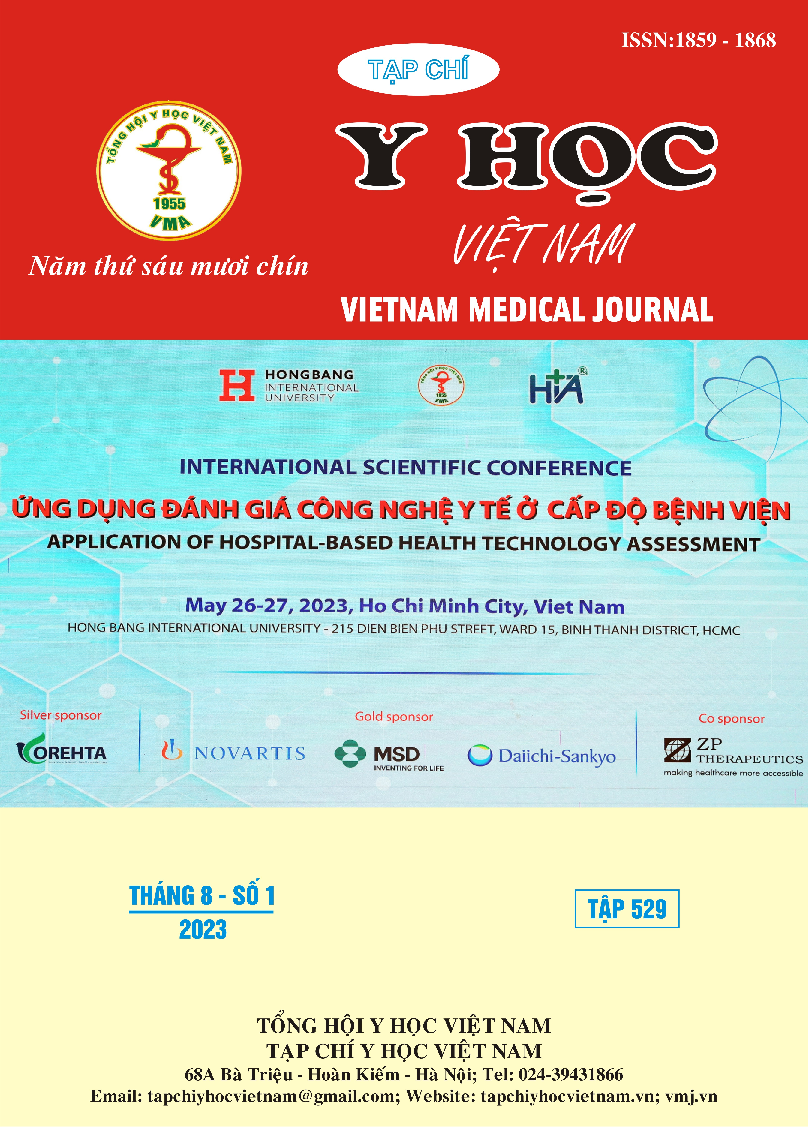COMPLICATIONS AND RISK FACTORS AFTER CARDIAC ELECTROPHYSIOLOGICAL STUDY AND RADIOFEQUENCY CATHETER ABLATION AT THANH HOA GENERAL HOSPITAL
Main Article Content
Abstract
Objectives: The study was conducted with the objectives of investigating complications and factors a newly cardiovascular center. Subjects and methods: A cross-sectional, cluster-descriptive study on 144 patients with longitudinal follow-up after 01 month at Thanh Hoa Provincial General Hospital from February 2022 to October 2022. Results: Complications recorded related to cardiac electrophysiological study and radiofrequency catheter ablation: Complications of vascular access: pseudoaneurysm of femoral artery 05 (3.5%) cases, hematoma 14 (9.7%) cases, arteriovenous catheterization 01 (0.69%) cases and thrombosis 10 (6.9%) cases. After the procedure, transient atrioventricular block 03 (2.97%) cases, complete right bundle branch block 01 (0.99%) cases, severe pain 13 (12.8%) cases, vagal hypertrophy 03 (2.97%) cases. Factors related to the likelihood of complications, age ≥ 70 years, comorbidities, especially hypertension, number of sheaths used ≥ 3 and sheath size > 8F (p < 0.005).
Article Details
Keywords
Cardiac electrophysiological study, radiofrequency catheter ablation, complications.
References
2. Borggrefe M, Budde T, Podczeck A, Breithardt G. High frequency alternating current ablation of an accessory pathway in humans. J Am Coll Cardiol. 1987;10(3):576-582. doi:10.1016/S0735-1097(87)80200-0
3. Kelm M, Perings SM, Jax T, et al. Incidence and clinical outcome of iatrogenic femoral arteriovenous fistulas. J Am Coll Cardiol. 2002; 40 (2): 291-297. doi:10.1016/S0735-1097(02)01966-6
4. Dimarco JP. Complications in Patients Undergoing Cardiac Electrophysiologic Procedures. Ann Intern Med. 1982;97(4):490. doi:10.7326/0003-4819-97-4-490
5. Scheinman MM, Huang S. The 1998 NASPE Prospective Catheter Ablation Registry. Pacing Clin Electrophysiol. 2000;23(6):1020-1028. doi:10.1111/j.1540-8159. 2000.tb00891.x
6. Calkins H, Yong P, Miller JM, et al. Catheter Ablation of Accessory Pathways, Atrioventricular Nodal Reentrant Tachycardia, and the Atrioventricular Junction: Final Results of a Prospective, Multicenter Clinical Trial. Circulation. 1999; 99(2):262-270. doi: 10.1161/ 01.CIR.99.2.262
7. Hindricks G, ON BEHALF OF THE MULTICENTRE EUROPEAN RADIOFREQUENCY SURVEY (MERFS) INVESTIGATORS OF THE WORKING GROUP ON ARRHYTHMIAS OF THE EUROPEAN SOCIETY OF CARDIOLOGY. The Multicentre European Radiofrequency Survey (MERFS): Complications of radiofrequency catheter ablation of arrhythmias. Eur Heart J. 1993;14(12):1644-1653. doi:10.1093/eurheartj/14.12.1644
8. Feldman A, Voskoboinik A, Kumar S, et al. Predictors of Acute and Long-Term Success of Slow Pathway Ablation for Atrioventricular Nodal Reentrant Tachycardia: A Single Center Series of 1,419 Consecutive Patients: PREDICTORS OF ACUTE AND LONG-TERM SUCCESS OF SLOW PATHWAY ABLATION. Pacing Clin Electrophysiol. 2011; 34(8):927-933. doi:10.1111/j.1540-8159. 2011. 03092.x
9. Kobza R, Kottkamp H, Piorkowski C, et al. Radiofrequency ablation of accessory pathways: Contemporary success rates and complications in 323 patients. Z F�r Kardiologie. 2005;94(3):193-199. doi:10.1007/s00392-005-0202-9
10. Tamanaha Y, Sakakura K, Taniguchi Y, et al. Comparison of Postcatheterization Pseudoaneurysm between Brachial Access and Femoral Access. Int Heart J. 2019;60(5):1030-1036. doi:10.1536/ihj.18-551


